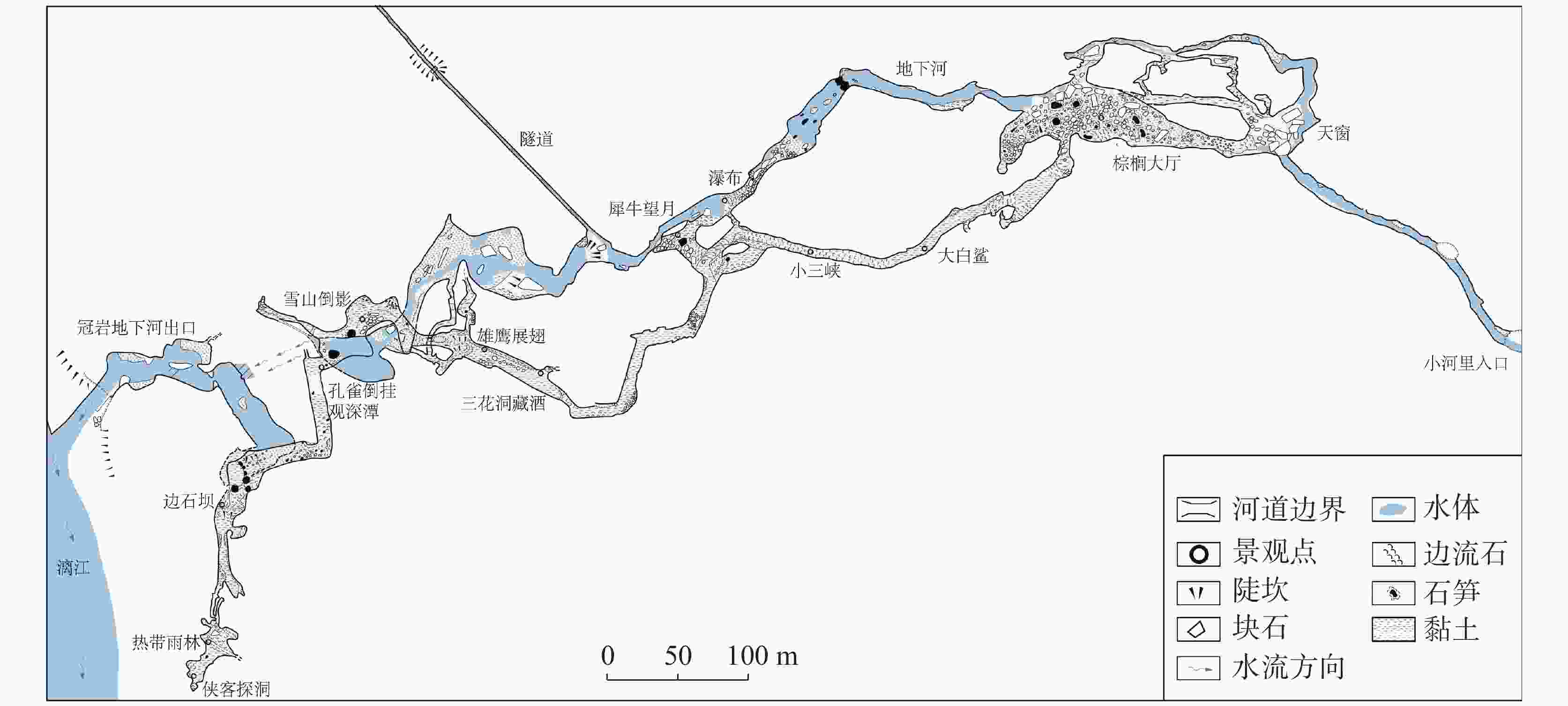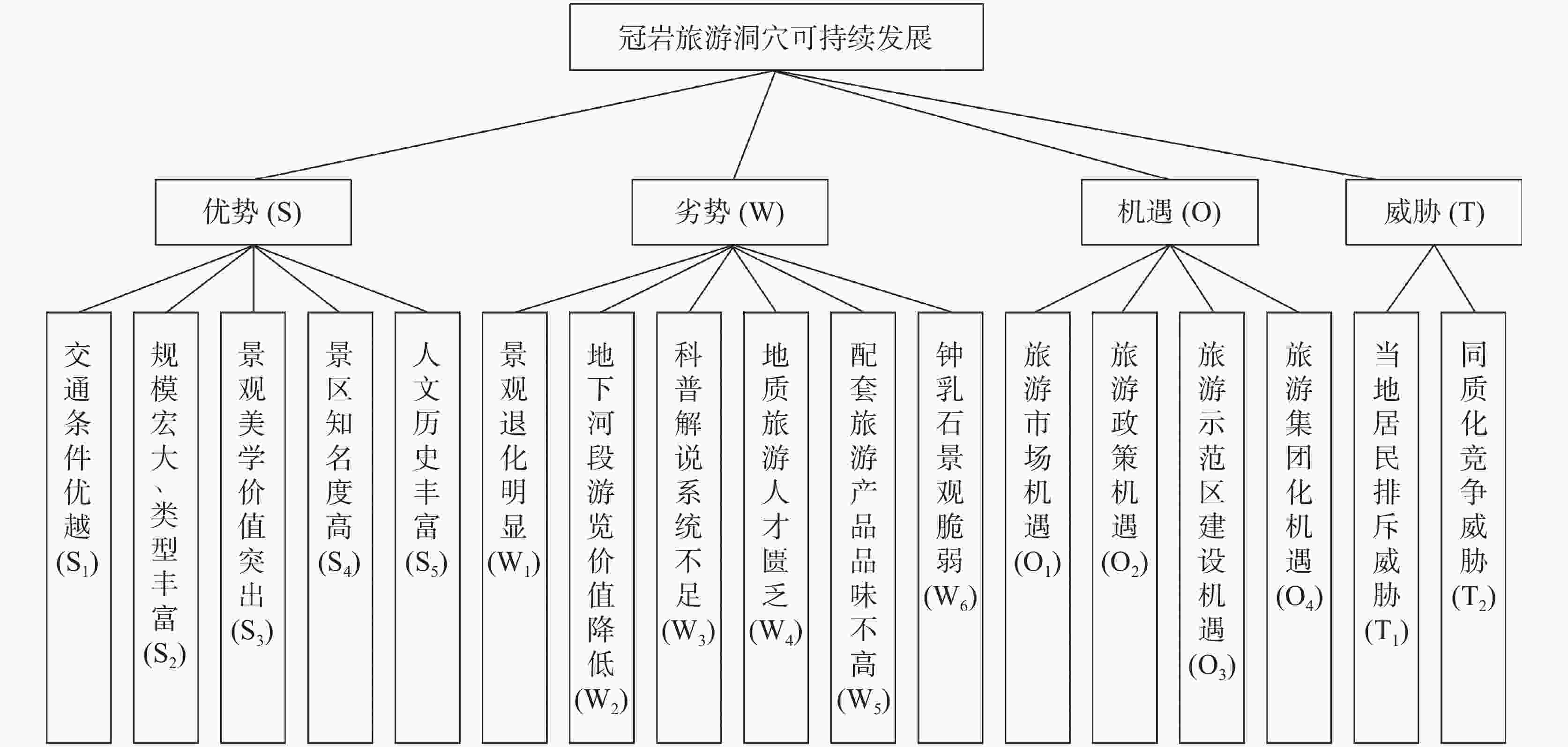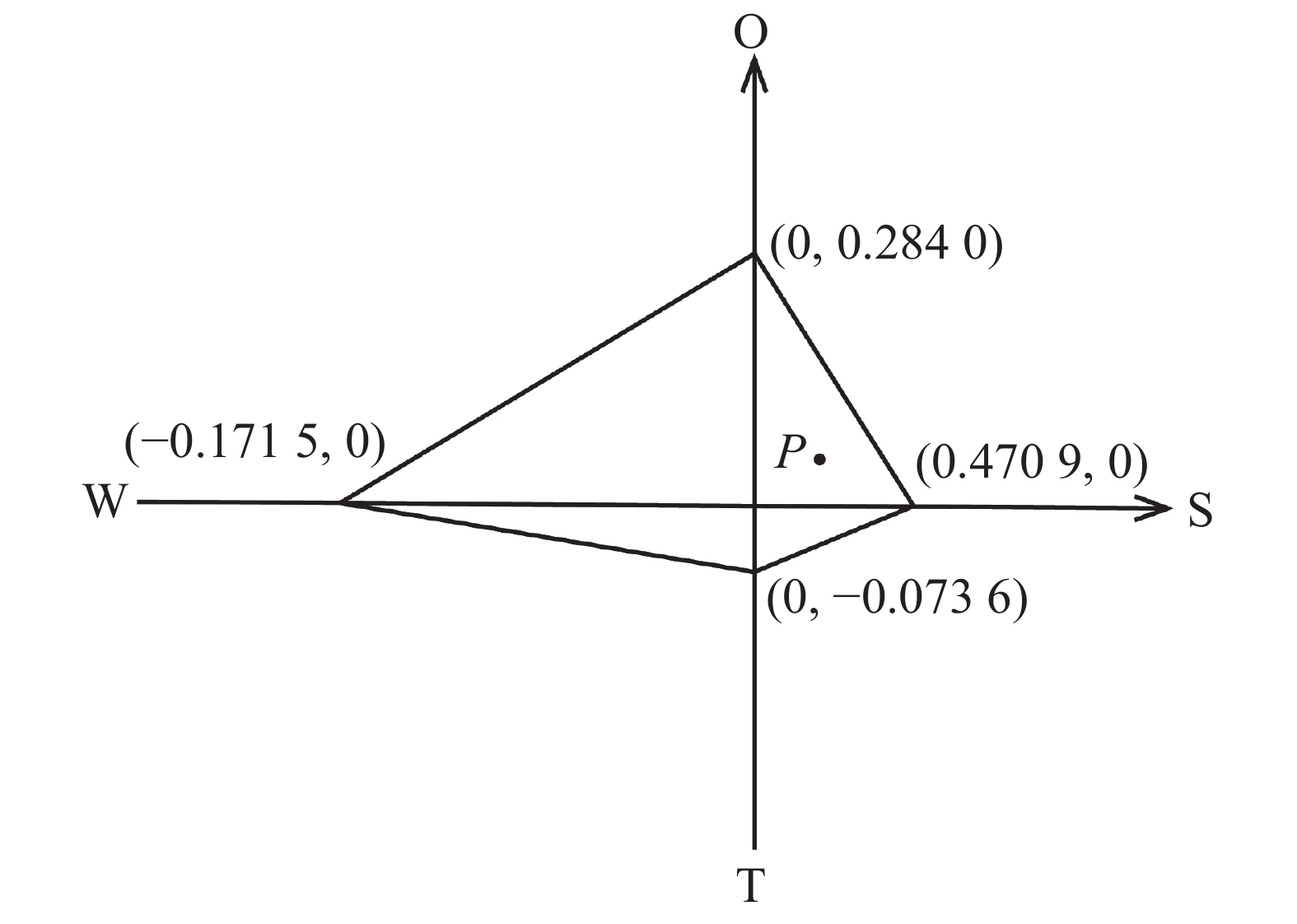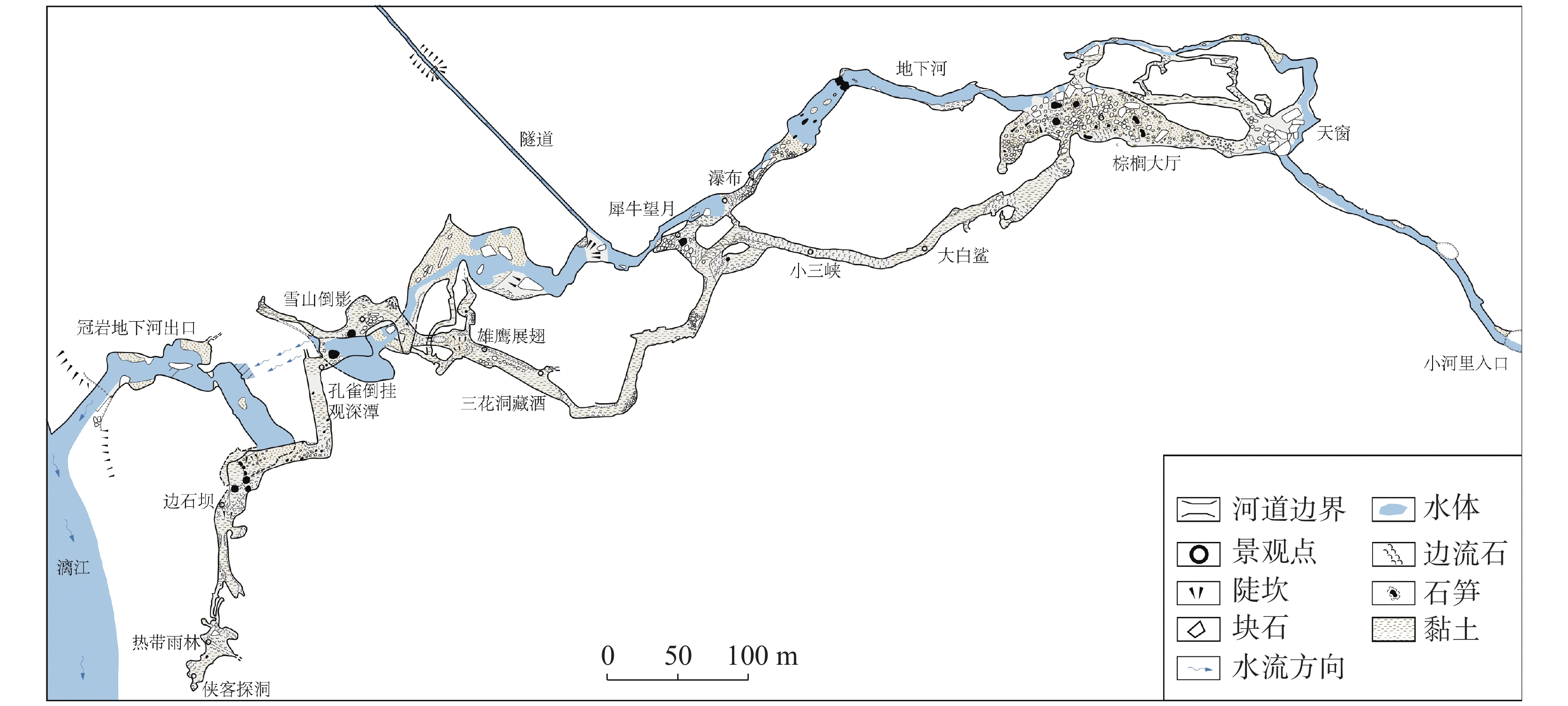Strategies for the sustainable tourism development of Guanyan cave based on SWOT-AHP analysis
-
摘要: 文章运用SWOT法分析了冠岩旅游洞穴优势、劣势、机遇与威胁;采用AHP构建递阶层次结构体系和判断矩阵,计算出各因素权重,绘制战略四边形,确定冠岩可持续发展方向。结果表明:(1)冠岩可持续发展的优势>机遇>劣势>威胁。景区知名度高是冠岩可持续发展的最大优势,景观退化明显是影响可持续发展的最大劣势;旅游市场机遇是冠岩可持续发展的最大机遇;同质化竞争是当前面临的最大威胁。(2)通过四象限坐标法分析,确定战略坐标P(
0.0749 ,0.0526 ),P位于为第一象限,得出冠岩旅游洞穴可持续发展应选取SO战略模式。(3)结合冠岩旅游洞穴SWOT分析,提出冠岩持续发展策略:利用内部优势,提升旅游形象;治理地下河,恢复旅游品牌特色;借助政策机遇,建立可持续发展示范点;借助市场机遇,建立多元化旅游产品;借助示范区建设机遇,构建生态旅游圈;借助集团优势,提高企业竞争力;加强管理,严格保护;培养旅游人才,提升旅游服务质量;鼓励当地居民参与,提升居民景区归属感。-
关键词:
- SWOT-AHP模型 /
- 旅游洞穴 /
- 战略分析 /
- 可持续发展策略 /
- 冠岩
Abstract:Predominantly forming in the Devonian light gray, thick-bedded limestone, Guanyan cave is located in Caoping township, Yanshan district, Guilin. In 1985, Guanyan cave was explored by a joint Sino-British expedition team. After planned and designed in 1992, it was officially opened to the public on October 1, 1995. The designed tour path is approximately 2.8 km long and is renowned for its unique three-dimensional cave exploration experience of "sea, land and air". Over nearly three decades since its opening, Guanyan cave has achieved good economic benefits. However, with the construction of cave engineering and the influx of tourists, some of the cave's sedimentary landscapes have gradually turned black and dark, peeled off, and weathered, directly affecting the scientific and aesthetic value of Guanyan cave, thereby weakening its capacity for sustainable tourism development. To investigate the sustainability of tourism development in Guanyan cave, this study employs a perspective of sustainable development strategy and utilizes the SWOT analysis to assess the internal strengths and weaknesses, as well as the external opportunities and threats affecting the sustainable tourism development of Guanyan cave. The study identifies the key factors influencing sustainability and employs the Analytic Hierarchy Process (AHP) to determine the importance of these factors. Furthermore, a strategic model for sustainable development has been established through the SWOT quadrants. Based on the actual tourism conditions of Guanyan cave, targeted strategies and recommendations for sustainable development have been proposed. This study has obtained the following results,(1) According to the analysis of SWOT, the relationship of the related factors is as follow, strengths>weaknesses>opportunities>threats. The biggest strength of sustainable development of Guanyan cave lies in its great popularity of the scenic area, while its biggest weakness is the obvious degradation of landscape. The biggest opportunity of this cave roots in the tourism market while its biggest threat comes from homogeneous tourism competition. (2) Through the four-quadrant coordinate method, the strategic coordinate P (x, y) is determined to be P (0.0749, 0.0526), and P is located in the first quadrant. It is concluded that the SO strategic model should be selected for the sustainable tourism development of Guanyan cave. (3) Based on the SWOT analysis, the following strategies for sustainable tourism development of Guanyan cave are proposed: utilizing internal strengths to enhance the tourism image, managing the underground river to restore the unique characteristics of the tourism brand, leveraging policy opportunities to establish demonstration zones for sustainable development, taking advantage of market opportunities to create diversified tourism products, capitalizing on the opportunities presented by the establishment of demonstration zones to build an ecological tourism circle, using the advantages of the cooperations to improve corporate competitiveness, strengthening management and enforcing strict protection, cultivating tourism talent to improve the quality of tourism services, and encouraging local residents to participate the development to enhance their sense of belonging to the scenic area. Based on the actual tourism development of Guanyan cave, the application of the SWOT-AHP method to determine the strategic direction for sustainable development of cave tourism enables the precise formulation of sustainable development countermeasures. This approach holds significant reference to the sustainable tourism development of similar cave projects. -
Key words:
- SWOT-AHP model /
- tourism cave /
- strategic analysis /
- sustainable development strategy /
- Guanyan cave
-
表 1 冠岩旅游洞穴可持续发展指标体系权重分配
Table 1. Weight distribution of sustainable tourism development of Guanyan cave
目标层(A) 准则层(B) 权重 指标层(C) 权重 冠岩旅游洞穴
可持续发展优势(S) 0.4709 交通条件优越(S1) 0.0558 规模宏大、类型丰富(S2) 0.1010 景观美学价值突出(S3) 0.1356 景区知名度高(S4) 0.1505 人文历史丰富(S5) 0.0280 劣势(W) 0.1715 景观退化明显(W1) 0.0769 地下河段游览价值降低(W2) 0.0324 科普解说系统不足(W3) 0.0065 地质旅游人才匮乏(W4) 0.0100 配套旅游产品品味不高(W5) 0.0187 钟乳石景观脆弱(W6) 0.0270 机遇(O) 0.2840 旅游市场机遇(O1) 0.1493 旅游政策机遇(O2) 0.0775 旅游示范区建设机遇(O3) 0.0353 旅游集团化机遇(O4) 0.0219 威胁(T) 0.0736 当地居民排斥威胁(T1) 0.0092 同质化竞争威胁(T2) 0.0644 -
[1] 曹翔, 杨晓霞, 李溪, 向旭, 孙晓蓓. 中国旅游洞穴景区(点)的统计分析[J]. 中国岩溶, 2017, 36(2):264-274. doi: 10.11932/karst20170215CAO Xiang, YANG Xiaoxia, LI Xi, XIANG Xu, SUN Xiaobei. Statistical analysis of show cave scenic areas (spots) in China[J]. Carsologica Sinica, 2017, 36(2): 264-274. doi: 10.11932/karst20170215 [2] 杨明德. 岩溶洞穴旅游资源特性与开发保护[J]. 中国岩溶, 1998, 17(3):233-238.YANG Mingde. The characteristics and protection of karst cave tourism resources[J]. Carsologica Sinica, 1998, 17(3): 233-238. [3] 邓亚东, 陈伟海, 罗书文, 孟庆鑫, 史文强, 李乐乐. 旅游洞穴景观脆弱性概念与评价研究[J]. 西南大学学报(自然科学版), 2020, 42(8):129-137.DENG Yadong, CHEN Weihai, LUO Shuwen, MENG Qingxin, SHI Wenqiang, LI Lele. Research of the concept of "landscape vunerability of toutist caves" and its evaluation[J]. Journal of Southwest University (Natural Science Edition), 2020, 42(8): 129-137. [4] 崔洪瑞, 杨晓霞, 陶沛然. 基于Logistic-ISM模型洞穴旅游地游客环境责任行为意向的影响因素[J]. 中国岩溶, 2021, 40(6):995-1005.CUI Hongrui, YANG Xiaoxia, TAO Peiran. Factors affecting tourists′ intention of environmental responsibility behavior in karst cave tourist destinations: Based on Logistic-ISM model[J]. Carsologica Sinica, 2021, 40(6): 995-1005. [5] World Commission on Environment and Development. Our common future[M]. New York, USA: Oxford University Press, 1987: 45-47. [6] 张凌云. 可持续发展:旅游业高质量发展的新议程[J]. 旅游学刊, 2023, 38(1):1-2. [7] 向旭, 杨晓霞, 施俊庄. 洞穴旅游容量测算方法探讨[J]. 中国岩溶, 2010, 29(3):341-348. doi: 10.3969/j.issn.1001-4810.2010.03.019XIANG Xu, YANG Xiaoxia, SHI Junzhuang. Research on calculating methods for tourism carrying capacity of caves[J]. Carsologica Sinica, 2010, 29(3): 341-348. doi: 10.3969/j.issn.1001-4810.2010.03.019 [8] 陈伟海, 邓亚东, 唐立, 韦跃龙, 阳和平. 桂林旅游洞穴可持续利用研究[J]. 广西科学, 2018, 25(5):579-589.CHEN Weihai, DENG Yadong, TANG Li, WEI Yuelong, YANG Heping. Study on sustainable utilization of show caves in Guilin City[J]. Guangxi Sciences, 2018, 25(5): 579-589. [9] 贺卫, 李坡. 贵州喀斯特洞穴旅游可持续发展对策探讨[J]. 绿色科技, 2016(3):173-175, 178. doi: 10.3969/j.issn.1674-9944.2016.03.092 [10] 邓亚东, 陈伟海, 张远海, 陈旺, 易旭敏. 岩溶洞穴旅游开发对生态环境影响分析:以巴马水晶宫为例[J]. 桂林理工大学学报, 2011, 31(3):412-417.DENG Yadong, CHEN Weihai, ZHANG Yuanhai, CHEN Wang, YI Xumin. Ecological environment influenced by karst show cave exploitation: A case study on Shuijinggong cave in Bama[J]. Journal of Guilin University of Technology, 2011, 31(3): 412-417. [11] 朱晓燕, 张美良. 基于岩溶洞穴旅游活动中洞穴环境因子的研究[J]. 中国岩溶, 2020, 39(3):426-431. doi: 10.11932/karst2020y14ZHU Xiaoyan, ZHANG Meiliang. Study on cave environmental factors based on karst cave tourism activities[J]. Carsologica Sinica, 2020, 39(3): 426-431. doi: 10.11932/karst2020y14 [12] 张美良, 朱晓燕, 吴夏, 张碧云, 潘谋成. 地下河水人工补给洞穴滴水、碳酸盐(钙)沉积特征及景观恢复探讨[J]. 中国岩溶, 2015, 34(1):17-26.ZHANG Meiliang, ZHU Xiaoyan, WU Xia, ZHANG Biyun, PAN Moucheng. Characteristics of cave drip water and modern carbonate (CaCO3) deposits caused by underground river artificilal recharge and landscape restoration[J]. Carsologica Sinica, 2015, 34(1): 17-26. [13] 张美良, 朱晓燕, 吴夏, 张碧云, 潘谋成. 旅游活动对巴马水晶宫洞穴环境及碳酸钙沉积物景观的影响[J]. 中国岩溶, 2017, 36(1):119-130.ZHANG Meiliang, ZHU Xiaoyan, WU Xia, ZHANG Biyun, PAN Moucheng. Impact of tourism activities on the cave environment and landscape of calcium carbonate (CaCO3) deposits at Shuijinggong cave, Bama county[J]. Carsologica Sinica, 2017, 36(1): 119-130. [14] 邓亚东, 杨洪勇, 郭小红, 陈镭友, 陈愉, 张宁静. 旅游洞穴景点保护等级评价:以重庆酉阳太古洞为例[J]. 中国岩溶, 2021, 40(6):987-994.DENG Yadong, YANG Hongyong, GUO Xiaohong, CHEN Leiyou, CHEN Yu, ZHANG Ningjing. Evaluation of graded protection of scenic spots in tourist caves: A case study of Taigu cave, Youyang, Chongqing[J]. Carsologica Sinica, 2021, 40(6): 987-994. [15] 李亚, 任敬, 赵福祥. 云南喀斯特洞穴型旅游目的地生命周期调控机制研究[J]. 云南地理环境研究, 2003, 15(4):26-31.LI Ya, REN Jing, ZHAO Fuxiang. Control mechanism study on lifecycle of karst cave in Yunnan[J]. Yunnan Geographic Environment Research, 2003, 15(4): 26-31. [16] 邓贵平. 岩溶洞穴旅游地生命周期延长研究:以川西北最大溶洞匡山佛爷洞为例[D]. 成都:四川师范大学, 2007.DENG Guiping. Study of extending the life cycle of the karst cave tourist destination: Take the Buddha cave for example, which is the biggest karst cave in northwest of Sichuan[D]. Chengdu: Sichuan Normal University, 2007. [17] 杨晓霞, 蒙歆媛, 向旭. 我国洞穴旅游从业者安全认知研究[J]. 中国岩溶, 2019, 38(1):139-147.YANG Xiaoxia, MENG Xinyuan, XIANG Xu. Study on the safety cognition of cave tourism practitioners in China[J]. Carsologica Sinica, 2019, 38(1): 139-147. [18] 胡群, 刘文云. 基于层次分析法的SWOT方法改进与实例分析[J]. 情报理论与实践, 2009, 32(3):68-71.HU Qun, LIU Wenyun. Improvement and example analysis of SWOT method based on analytic hierarchy process[J]. Information Studies: Theory & Application, 2009, 32(3): 68-71. [19] 潘旋宇. 基于SWOT的分宜洞村乡溶洞资源开发策略研究[J]. 中外企业家, 2012(6):62-64. [20] 吴发明, 何小芊, 罗梦悦. 万年县神农宫旅游资源综合评价与开发对策[J]. 中国岩溶, 2016, 35(2):233-242.WU Faming, HE Xiaoqian, LUO Mengyue. Comprehensive evaluation and exploitation strategy of tourism resources of Shennonggong in Wannian county[J]. Carsologica Sinica, 2016, 35(2): 233-242. [21] 张任. 冠岩洞穴特征与游览开发设计研究[J]. 中国岩溶, 1999, 18(1):73-79.ZHANG Ren. Characteristics and tourism exploitation planning of Guangyan cave[J]. Carsologica Sinica, 1999, 18(1): 73-79. [22] A G Olabi, Tabbi Wilberforce, Enas Taha Sayed, Ahmed G Abo Khalil, Hussein M Maghrabie, Khaled Elsaid, Mohammad Ali Abdelkareem. Battery energy storage systems and SWOT (strengths, weakness, opportunities, and threats) analysis of batteries in power transmission[J]. Energy, 2022, 254(Part A):123987. [23] 彭靖里, 王晓旭, 邓艺, 赵光洲. SWOT分析方法在竞争情报研究中的应用及其案例[J]. 情报杂志, 2005, 24(7):15-17. doi: 10.3969/j.issn.1002-1965.2005.07.006 [24] 要瑞璞, 沈惠璋, 刘铎. 多层次系统的综合评价方法研究[J]. 系统工程与电子技术, 2005, 27(4):656-658. doi: 10.3321/j.issn:1001-506X.2005.04.021YAO Ruipu, SHEN Huizhang, LIU Duo. Study on the synthetic evaluation method for the multilevel system[J]. Systems Engineering and Electronics, 2005, 27(4): 656-658. doi: 10.3321/j.issn:1001-506X.2005.04.021 [25] 宋志伟, 周红斌, 朱丽艳, 王海亮, 路飞, 吴落军. 基于SWOT-AHP的普洱市国家储备林发展战略分析[J]. 林业资源管理, 2022(2):19-26.SONG Zhiwei, ZHOU Hongbin, ZHU Liyan, WANG Hailiang, LU Fei, WU Luojun. Analysis on development strategy of Pu′er City national reserve forest based on SWOT-AHP method[J]. Forest Resources Management, 2022(2): 19-26. [26] 肖林刚, 宋兵伟, 曹新伟, 王瑞, 史慧锋, 吴乐天. 新疆沙漠地区皮山县设施农业发展的SWOT分析及对策研究[J]. 中国农机化学报, 2021, 42(5):139-147.XIAO Lingang, SONG Bingwei, CAO Xinwei, WANG Rui, SHI Huifeng, WU Letian. Study on SWOT analysis and countermeasures for the development of facility agriculture in Pishan county in Xinjiang desert region[J]. Journal of Chinese Agricultural Mechanization, 2021, 42(5): 139-147. [27] 玉米提, 史录文. AHP-SWOT法分析影响维吾尔医药产业发展因素[J]. 中国新药杂志, 2008, 17(24):2086-2088, 2107. doi: 10.3321/j.issn:1003-3734.2008.24.003YU Miti, SHI Luwen. Ananlysis of the impact factors in development of Uyghur medicine industry by AHP-SWOT[J]. Chinese Journal of new Drugs, 2008, 17(24): 2086-2088, 2107. doi: 10.3321/j.issn:1003-3734.2008.24.003 [28] 谈力, 任志宽, 韩莉娜. 基于SWOT-AHP分析模型的科技发展战略实证分析:来自广东的案例研究[J]. 科技管理研究, 2022, 42(5):42-49. doi: 10.3969/j.issn.1000-7695.2022.5.006TAN Li, REN Zhikuan, HAN Lina. Strategic analysis of scientific and technological innovation based on SWOT-AHP method: Taking Guangdong Province as an example[J]. Science and Technology Management Research, 2022, 42(5): 42-49. doi: 10.3969/j.issn.1000-7695.2022.5.006 [29] 刘瑾, 高同彪. 新经济形势下东北地区规模经济发展战略AHP-SWOT分析[J]. 东北师大学报(哲学社会科学版), 2022(2):111-127, 147.LIU Jin, GAO Tongbiao. AHP-SWOT analysis of northeast economies of scale development strategy under the new economic situation[J]. Journal of Northeast Normal University (Philosophy and Social Sciences), 2022(2): 111-127, 147. [30] 钱卫东, 刘彬霞, 刘志强, 顾新友. AHP-SWOT法在道路交通安全改善策略中的应用[J]. 中国安全科学学报, 2009, 19(4):121-126. doi: 10.3969/j.issn.1003-3033.2009.04.021QIAN Weidong, LIU Binxia, LIU Zhiqiang, GU Xinyou. Application of AHP-SWOT method in the improving of road traffic safety strategy[J]. Chinese Safety Science Journal, 2009, 19(4): 121-126. doi: 10.3969/j.issn.1003-3033.2009.04.021 [31] 韩炜, 严家高, 杭成强. 基于AHP-SWOT的山东滨海体育旅游发展战略研究[J]. 山东体育学院学报, 2019, 35(2):48-54.HAN Wei, YAN Jiagao, HANG Chengqiang. Development strategy of Shandong coastal sports tourism based on AHP-SWOT method[J]. Journal of Shandong Sport University, 2019, 35(2): 48-54. [32] 皮鹏程, 曾敏, 黄长生, 师环环, 侯清芹, 彭红霞. 基于SWOT-AHP模型的恩施州森林康养旅游可持续发展研究[J]. 华中师范大学学报(自然科学版), 2022, 56(1):127-139.PI Pengcheng, ZENG Min, HUANG Changsheng, SHI Huanhuan, HOU Qingqin, PENG Hongxia. A research on sustainable development of Enshi forest therapy tourism based on SWOT-AHP model[J]. Journal of Central China Normal University (Natural Sciences), 2022, 56(1): 127-139. [33] 徐建华. 现代地理学中的数学方法[M]. 北京:高等教育出版社, 2002: 224-251.XUN Jianhua. Mathematical methods in contemporary geography[M]. Beijing: Higher Education Press, 2002: 224-251. [34] 许庆, 侯兴明. 基于YAAHP软件实现的航天装备军民融合式维修保障风险评估[J]. 兵器装备工程学报, 2019, 40(5):99-104. doi: 10.11809/bqzbgcxb2019.05.022XU Qing, HOU Xingming. Risk assessment of military-civil integration space equipment maintenance support based on YAAHP software[J]. Journal of Ordnance Equipment Engineering, 2019, 40(5): 99-104. doi: 10.11809/bqzbgcxb2019.05.022 [35] 徐佳, 冯平, 王琪, 潘丽雯. 基于SWOT-AHP模型的农村饮水安全发展环境分析与战略选择[J]. 水利水电技术, 2015, 46(4):30-34, 43.XU Jia, FENG Ping, WANG Qi, PAN Liwen. SWOT-AHP model based-development environment analysis and strategy selection for rural drinking water safety[J]. Water Resources and Hydropower Engineering, 2015, 46(4): 30-34, 43. [36] Aaker J L. The malleable self: The role of self-expression in persuasion[J]. Journal of Marketing Research, 1999, 36(1): 45-57. doi: 10.1177/002224379903600104 -





 下载:
下载:




